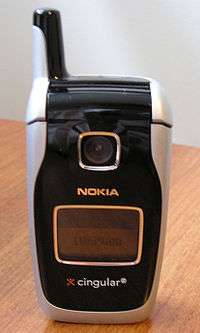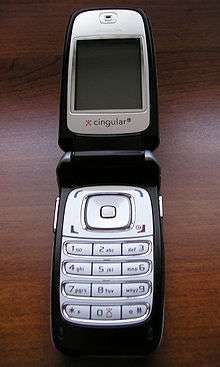Nokia 6101
The Nokia 6101, 6102, and 6102i are a line of popular Nokia mid-level clamshell cellphones that operate on GSM-850/1800/1900 MHz (some markets are GSM-900/1800/1900 MHz) frequencies released between middle 2005 and early 2006. The line was given the nickname Ediphix by Nokia employees.
| Manufacturer | Nokia |
|---|---|
| Compatible networks | GSM 900 1800 1900 GSM 850 1800 1900 (US) GPRS Class 10 (4+1/3+2 slots), 32-48 kbit/s HSCSD 43.2 kbit/s EDGE Class 6, 177.6 kbit/s |
| Form factor | clamshell |
| Battery | BL-4C 860 mAh Internal rechargeable li-ion |
| Data inputs | Keypad |
| Display | 1.8 in (46 mm) TFT 128x160 px 65k colors |
| External display | 96x65 px 4096 colors |
| Front camera | 640x480 px VGA video |
| Connectivity | Infrared USB pop-port (CA-42) |
| Other | Push to Talk FM Radio Java MIDP 2.0 SyncML T 9 Presence Enhanced Contacts Calendar Built-in handsfree Voice dial-memo |
 The Nokia 6102i Phone | |
| Manufacturer | Nokia |
|---|---|
| Compatible networks | GSM 900 1800 1900 GSM 850 1800 1900 (US) EDGE (EGPRS) class 6 / plus class 10 GPRS |
| Form factor | clamshell |
| Battery | 820 mAh Internal rechargeable li-ion |
| Display | LCD (Color TFT/TFD) 128x160 px 65,536 colors |
| External display | STN LCD 96x65 px 4,096 colors |
| Front camera | 640x480 px VGA |
| Connectivity | Bluetooth supported Profiles: HSP, HFP, DUN, OPP, FTP, SAP version 2.0 + EDR Infrared PC Sync USB |
| Other | FM Radio |

The differences between the 6101 and 6102 are very small and the only visible differences are the style of the keypads and front bezel plate. The 6102i is an updated version of the 6102 featuring Bluetooth capabilities and increased memory space. Another updated version of the 6101/6102 is the Nokia 6103.
Announced in 2005, the Nokia 6101 was also one of the very last Nokia phones that still had an external antenna.[1]
Its direct successor is the Nokia 6131, which includes microSD card slot and native USB connectivity.
Specifications
- Weight: 5 Ounces
- Dimensions: 3.35 x 1.77 x 0.95 inches (24 mm)
- Two color displays: 128 x 160 pixel internal display with up to 65,536 colors and external mini display
- Indicators for battery power and signal strength (audible indicators for both also available)
Nokia 6101 full phone specification[2]
Below are the complete specification of Nokia 6101
| Category | Type | Specification |
|---|---|---|
| General | 2G Network | GSM 900 / 1800 / 1900
GSM 850 / 1800 / 1900 - US Version |
| Size | Dimensions | 85 x 45 x 24 mm |
| Weight | 97 g | |
| Display | Type | TFT, 65k Colors |
| Size | 128 x 160 pixels, 1.8 inches, 29 x 35 mm
Second external display 4096 colors (96 x 65 pixels) / 5-way navi key / Downloadable themes | |
| Ringtones | Type | Polyphonic (24 Channels), MP3 |
| Vibration | yes | |
| Memory | Phonebook | 500 x 10 fields, Photo Call |
| Call Records | 20 dialed, 20 received, 20 missed calls | |
| Card Slots | no
4.4 MB Shared Memory | |
| Data | GPRS | Class 10 (4+1/3+2 slots), 32-48 kbit/s |
| HSCSD | Yes, 43.2 kbit/s | |
| EDGE | Class 6, 177.6 kbit/s | |
| 3G | no | |
| WLAN | no | |
| Bluetooth | no | |
| Infrared port | yes | |
| USB | Yes, Pop-port | |
| Features | Messaging | SMS, MMS, Email, Instant Messaging |
| Browser | WEAP, XHTML | |
| Games | 3 + downloadable | |
| Colors | Black | |
| Languages | Major European and Asia - Pacific Languages | |
| Camera | VGA, 640 x 480 pixels, video
Pust to Talk / FM Radio / Java MIDP 2.0 / SyncML / T 9 ? Presence Enhanced Contacts / Calendar / Built-in handsfree / Voice dial-memo | |
| Battery | Standard Battery, Li-Lon 760 mAh (BL-4C) | |
| Stand-by | Up to 350 h | |
| Talk Time | Up to 4 h | |
Complete list of 6102i specifications[3]
The complete Nokia 6103 / 6102i list of specifications are :
| Type | Specification | |
|---|---|---|
| Modes | GSM 850 / GSM 1900 / GSM 1800 or GSM 900 for Europe/Asia instead of 850 | |
| Weight | 3.42 oz (97 g) | |
| Dimensions | 3.35" x 1.77" x 0.94" (85 x 45 x 24 mm) | |
| Form Factor | Clamshell Stub Antenna | |
| Battery Life | Talk: 3.50 hours (210 minutes) Standby: 336 hours (14 days) | |
| Battery Type | LiIon 820 mAh | |
| Display | Type: LCD (Color TFT/TFD) Colors: 65,536 (16-bit) Resolution: 128 x 160 pixels | |
| Platform / OS | (N/A) | |
| Memory | 4.2 MB (built-in, flash shared memory) | |
| Phone Book Capacity | shared memory | |
| FCC ID | PPIRM-161 (Approved Feb 9, 2006) PPIRM-162 (Approved Mar 14, 2006) | |
| Multiple Languages | Yes | |
| External Display | Location: Front 4,096-color STN LCD / 96 x 65 pixels | |
| Polyphonic Ringtones | Yes | |
| Ringer Profiles | Yes | |
| Vibrate | Yes | |
| Bluetooth | Supported Profiles: HSP, HFP, DUN, OPP, FTP, SAP version 2.0 + EDR | |
| Infrared (IR) | Yes | |
| PC Sync | Yes | |
| USB | Yes | |
| Multiple Numbers per Name | Yes | |
| Picture ID | Yes | |
| Voice Dialing | Yes | |
| Custom Graphics | Yes | |
| Custom Ringtones | supports MP3, MIDI formats | |
| Data-Capable | Yes | |
| Packet Data | Technology: EDGE (EGPRS) class 6 / plus class 10 GPRS | |
| WAP / Web Browser | xHTML | |
| Predictive Text Entry | Yes | |
| Side Keys | Yes | |
| Email Client | Yes | |
| MMS | Yes | |
| Text Messaging | 2-Way: Yes plus IM | |
| Text Messaging Templates | Yes | |
| FM Radio | Stereo: Yes | |
| Camera | Resolution: VGA (640 x 480) | |
| Video Capture | subQCIF resolution (128 x 96 pixels) / H.263 format / 65,000 colors | |
| Alarm | Yes | |
| Calculator | Yes | |
| Calendar | Yes | |
| SyncML | Yes | |
| To-Do List | Yes | |
| Voice Memo | Yes | |
| Games | Yes | |
| Java ME | Version: MIDP 2.0 | |
| Push-To-Talk | Some versions only Type: PoC | |
| Speaker Phone | Yes |